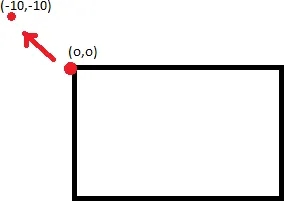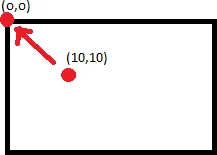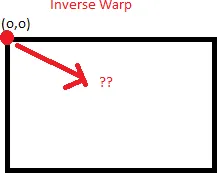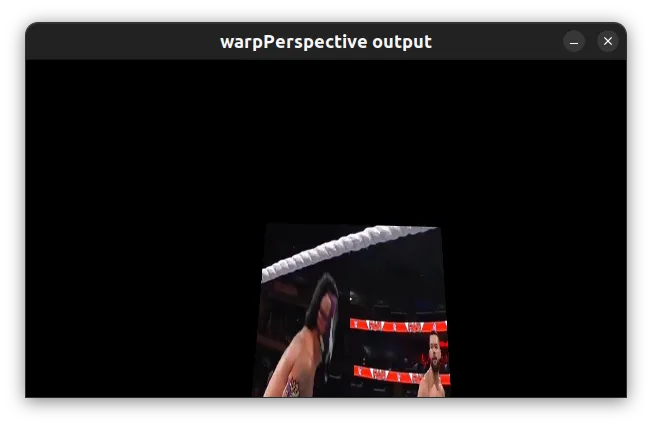由于某种原因,每当我使用OpenCV的warpPerspective()函数时,最终变形图像并不包含原始图像中的所有内容。图像左侧似乎被剪裁了。我认为这是发生的原因是因为warpPerspective()在画布的最左边位置创建了变形图像。有没有什么办法可以解决这个问题?谢谢。
单应性矩阵可以使用矩阵乘法组合(这就是它们如此强大的原因)。如果A和B是单应性矩阵,则AB表示先应用B,然后再应用A的单应性矩阵。
因此,我们只需要为某个偏移创建一个平移的单应性矩阵,然后将其与我们原始的单应性矩阵进行预乘即可实现输出偏移。
2D单应性矩阵的格式如下:
[R11,R12,T1]
[R21,R22,T2]
[ P , P , 1]
其中,R代表旋转矩阵,T代表平移,P代表透视变换。因此,纯平移单应矩阵如下:
[ 1 , 0 , x_offset]
[ 0 , 1 , y_offset]
[ 0 , 0 , 1 ]
所以,只需将您的单应性矩阵与类似上述的矩阵进行预乘,您的输出图像就会发生偏移。
(请确保使用矩阵乘法,而不是逐元素相乘!)
2
[ 1 , 0 , x_offset]
[ 0 , 1 , y_offset]
[ 0 , 0 , 1 ]
但是他没有具体说明x_offset和y_offset是什么。其他答案说只需进行透视变换,但这是不正确的。您需要进行逆透视变换。
仅仅因为一个点(0,0)被转换为(-10,-10),并不能保证将图像移位10,10就会得到非裁剪的图像。这是因为点(10,10)不一定映射到(0,0)。
要做的是找出哪个点将映射为(0,0),并将图像移动相应的量。为此,您需要取逆矩阵(cv2.invert) ,并应用perspectiveTransform。
您需要应用反向变换才能找到正确的点。
这将获得正确的x_offset和y_offset来对齐您的左上角点。从那里开始,为了找到正确的边界框并完美地适应整个图像,您需要找出扭曲(图像在正常的非反向变换后向左或向上倾斜的程度)并将该量添加到您的x_offset和y_offset中。
编辑:这只是理论。在我的测试中,图片稍微偏移了几个像素,我不知道为什么。
1
我已经完成了一种方法……它是有效的。
perspectiveTransform(obj_corners,scene_corners,H);
int maxCols(0),maxRows(0);
for(int i=0;i<scene_corners.size();i++)
{
if(maxRows < scene_corners.at(i).y)
maxRows = scene_corners.at(i).y;
if(maxCols < scene_corners.at(i).x)
maxCols = scene_corners.at(i).x;
}
我只是找到了x坐标和y坐标的最大值,并将它们放在了...
warpPerspective( tmp, transformedImage, homography, Size( maxCols, maxRows ) );
使用getPerspectiveTransform()计算正确的变换。从原始图像中取4个点,计算它们在目标图像中的正确位置,按相同顺序将它们放入两个向量中,并使用它们计算透视变换矩阵。
确保目标图像大小(warpPerspective()的第三个参数)正是您想要的。将其定义为Size(myWidth, myHeight)。
尝试下面的homography_warp。
void homography_warp(const cv::Mat& src, const cv::Mat& H, cv::Mat& dst);
src 是源图像。
H 是您的单应性矩阵。
dst 是变换后的图像。
homography_warp 调整您的单应性矩阵,如 https://stackoverflow.com/users/1060066/matt-freeman 在他的答案 https://dev59.com/BW025IYBdhLWcg3wT0Lq#8229116 中所描述的那样。
// Convert a vector of non-homogeneous 2D points to a vector of homogenehous 2D points.
void to_homogeneous(const std::vector< cv::Point2f >& non_homogeneous, std::vector< cv::Point3f >& homogeneous)
{
homogeneous.resize(non_homogeneous.size());
for (size_t i = 0; i < non_homogeneous.size(); i++) {
homogeneous[i].x = non_homogeneous[i].x;
homogeneous[i].y = non_homogeneous[i].y;
homogeneous[i].z = 1.0;
}
}
// Convert a vector of homogeneous 2D points to a vector of non-homogenehous 2D points.
void from_homogeneous(const std::vector< cv::Point3f >& homogeneous, std::vector< cv::Point2f >& non_homogeneous)
{
non_homogeneous.resize(homogeneous.size());
for (size_t i = 0; i < non_homogeneous.size(); i++) {
non_homogeneous[i].x = homogeneous[i].x / homogeneous[i].z;
non_homogeneous[i].y = homogeneous[i].y / homogeneous[i].z;
}
}
// Transform a vector of 2D non-homogeneous points via an homography.
std::vector<cv::Point2f> transform_via_homography(const std::vector<cv::Point2f>& points, const cv::Matx33f& homography)
{
std::vector<cv::Point3f> ph;
to_homogeneous(points, ph);
for (size_t i = 0; i < ph.size(); i++) {
ph[i] = homography*ph[i];
}
std::vector<cv::Point2f> r;
from_homogeneous(ph, r);
return r;
}
// Find the bounding box of a vector of 2D non-homogeneous points.
cv::Rect_<float> bounding_box(const std::vector<cv::Point2f>& p)
{
cv::Rect_<float> r;
float x_min = std::min_element(p.begin(), p.end(), [](const cv::Point2f& lhs, const cv::Point2f& rhs) {return lhs.x < rhs.x; })->x;
float x_max = std::max_element(p.begin(), p.end(), [](const cv::Point2f& lhs, const cv::Point2f& rhs) {return lhs.x < rhs.x; })->x;
float y_min = std::min_element(p.begin(), p.end(), [](const cv::Point2f& lhs, const cv::Point2f& rhs) {return lhs.y < rhs.y; })->y;
float y_max = std::max_element(p.begin(), p.end(), [](const cv::Point2f& lhs, const cv::Point2f& rhs) {return lhs.y < rhs.y; })->y;
return cv::Rect_<float>(x_min, y_min, x_max - x_min, y_max - y_min);
}
// Warp the image src into the image dst through the homography H.
// The resulting dst image contains the entire warped image, this
// behaviour is the same of Octave's imperspectivewarp (in the 'image'
// package) behaviour when the argument bbox is equal to 'loose'.
// See http://octave.sourceforge.net/image/function/imperspectivewarp.html
void homography_warp(const cv::Mat& src, const cv::Mat& H, cv::Mat& dst)
{
std::vector< cv::Point2f > corners;
corners.push_back(cv::Point2f(0, 0));
corners.push_back(cv::Point2f(src.cols, 0));
corners.push_back(cv::Point2f(0, src.rows));
corners.push_back(cv::Point2f(src.cols, src.rows));
std::vector< cv::Point2f > projected = transform_via_homography(corners, H);
cv::Rect_<float> bb = bounding_box(projected);
cv::Mat_<double> translation = (cv::Mat_<double>(3, 3) << 1, 0, -bb.tl().x, 0, 1, -bb.tl().y, 0, 0, 1);
cv::warpPerspective(src, dst, translation*H, bb.size());
}
4
warpPerspective()的运行良好。 没有必要重新编写它。 您可能使用不正确。
请记住以下提示:
- (0,0)像素不在中心,而是左上角。 因此,如果将图像放大2倍,则会丢失下部和右侧部分,而不是边框(例如在matlab中)。
- 如果您两次变形图像,则最好将转换相乘并激活函数一次。
- 我认为它仅适用于char / int矩阵,而不适用于float / double。
- 当您进行变换时,首先应用缩放/倾斜/旋转/透视,最后是平移。 因此,如果图像的某些部分丢失了,请更改矩阵中最后一列的两个上方行中的平移。
2
Mat tmp; cv::resize( imageList[image1], tmp, Size(), scaleFactor, scaleFactor ); warpPerspective( tmp, transformedImage, homography, Size( 2*tmp.cols, 2*tmp.rows ) ); - Hien翻译的概念已经在其他回答中讨论过了,因此我将解释如何获取正确的偏移量。想法是,在两个图像中匹配的特征应在最终拼接图像中具有相同的坐标。
假设我们将图像称为以下内容:
- '源图像'(si):需要进行扭曲的图像 - '目标图像'(di):将“源图像”扭曲为其透视图的图像 - '扭曲后的源图像'(wsi):将源图像扭曲为目标图像透视图后的图像
以下是计算平移偏移量所需执行的操作:
- 在从单应性中采样出好的匹配并找到掩膜后,将最佳匹配的关键点(具有最小距离且为内点(应在从单应性计算得到的掩膜中获得值1))存储在
si和di中。假设最佳匹配的关键点在si和di中分别是bm_si和bm_di。 - 通过简单地将其与单应性矩阵(
H)相乘来查找bm_si在wsi中的位置。bm_wsi = np.dot(H,bm_si)bm_wsi = [x/bm_wsi[2] for x in bm_wsi] - 根据您要在
si变形(=wsi)的输出上放置di的位置,调整bm_di。例如,如果您想将左图像扭曲到右图像(使左图像为
si,右图像为di),则将在右侧wsi上放置di,因此bm_di[0] += si.shape[0] - 现在,在完成以上步骤之后
x_offset = bm_di[0] - bm_si[0]y_offset = bm_di[1] - bm_si[1] - 使用计算出的偏移量找到新的单应性矩阵并对
si进行变形。T = np.array([[1, 0, x_offset], [0, 1, y_offset], [0, 0, 1]])translated_H = np.dot(T.H)wsi_frame_size = tuple(2*x for x in si.shape)stitched = cv2.warpPerspective(si, translated_H, wsi_frame_size)stitched[0:si.shape[0],si.shape[1]:] = di
bm_si = [x1, y1,1]
bm_di = [x2, y2, 1]
这是我的解决方案
由于"warpPerspective()"函数中的第三个参数是一个变换矩阵,
我们可以创建一个变换矩阵,先将图像向后移动,然后旋转图像,最后将图像向前移动。
在我的情况下,我有一张高度为160像素、宽度为160像素的图片。 我想要围绕[80,80]旋转图像,而不是围绕[0,0]旋转。
首先,向后移动图像(即T1)
然后旋转图像(即R)
最后向前移动图像(即T2)
void rotateImage(Mat &src_img,int degree)
{
float radian=(degree/180.0)*M_PI;
Mat R(3,3,CV_32FC1,Scalar(0));
R.at<float>(0,0)=cos(radian);R.at<float>(0,1)=-sin(radian);
R.at<float>(1,0)=sin(radian);R.at<float>(1,1)=cos(radian);
R.at<float>(2,2)=1;
Mat T1(3,3,CV_32FC1,Scalar(0));
T1.at<float>(0,2)=-80;
T1.at<float>(1,2)=-80;
T1.at<float>(0,0)=1;
T1.at<float>(1,1)=1;
T1.at<float>(2,2)=1;
Mat T2(3,3,CV_32FC1,Scalar(0));
T2.at<float>(0,2)=80;
T2.at<float>(1,2)=80;
T2.at<float>(0,0)=1;
T2.at<float>(1,1)=1;
T2.at<float>(2,2)=1;
std::cerr<<T1<<std::endl;
std::cerr<<R<<std::endl;
std::cerr<<T2<<std::endl;
std::cerr<<T2*R*T1<<"\n"<<std::endl;
cv::warpPerspective(src_img, src_img, T2*R*T1, src_img.size(), cv::INTER_LINEAR);
}
height = 220
scaleX, shearX = 0.0, -1.0
shearY, scaleY = 1.0, 0.0
transX, transY = height, 0
shearXZ, shearYZ = 0.0, 0.0
warpMatrix = np.array([[scaleX, shearX, transX],
[shearY, scaleY, transY],
[shearXZ, shearYZ, 1]])
print(warpMatrix)
输出:
[[ 0. -1. 220.]
[ 1. 0. 0.]
[ 0. 0. 1.]]
然后:
rotatedImg = cv2.warpPerspective(src = img,
M = warpMatrix,
dsize = (height, width),
flags = cv2.INTER_LINEAR,
borderMode = cv2.BORDER_CONSTANT,
borderValue = 0)
原文链接
- 相关问题
- 4 实现OpenCV中的warpPerspective()方法
- 3 OpenCV:理解warpPerspective / 透视变换
- 4 OpenCv warpPerspective的homography元素含义
- 7 Python OpenCV warpPerspective 的背景设置
- 8 OpenCV warpPerspective - 如何确定目标图像的大小?
- 5 无法在Android上使用OpenCV的warpPerspective函数
- 15 OpenCV warpPerspective参数数量
- 5 OpenCV warpPerspective()中的离群像素
- 7 Android OpenCV中的getPerspectiveTransform和warpPerspective
- 10 理解opencv的warpperspective和warpaffine的最佳方法是什么?




